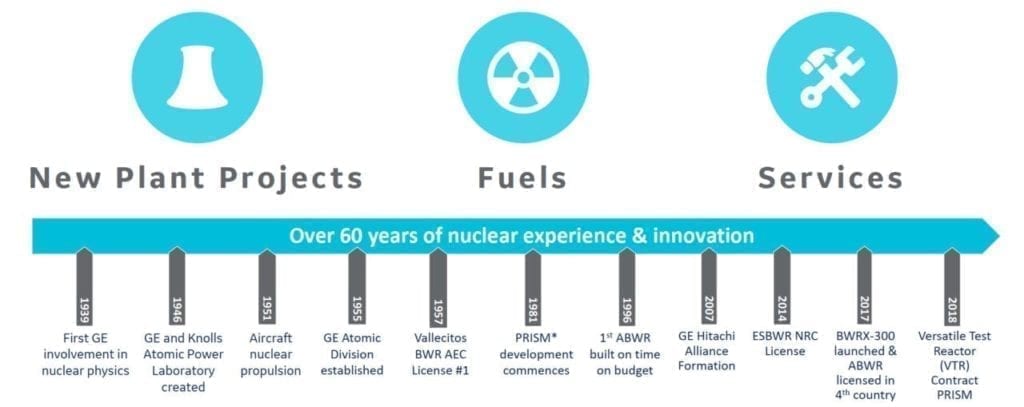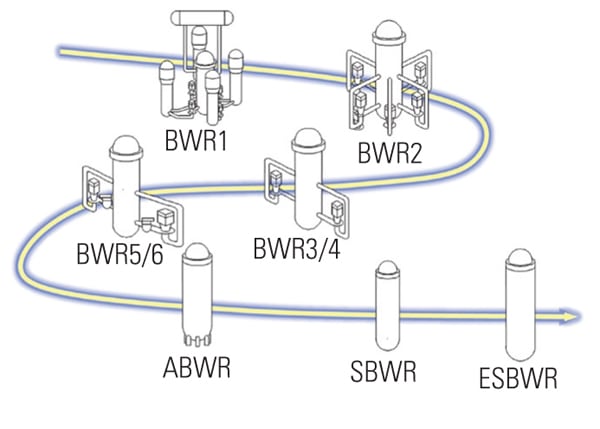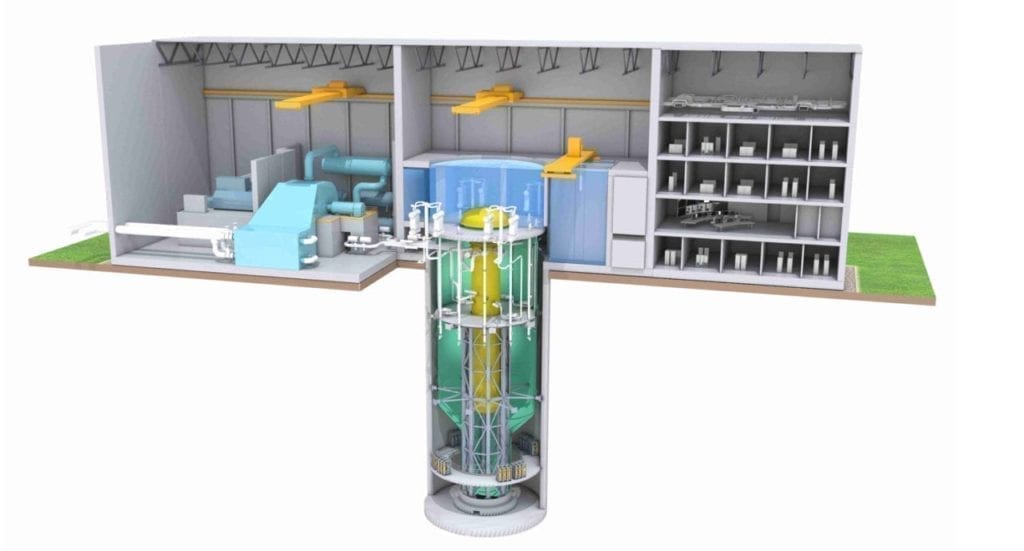GEH Launches NRC Licensing Process for BWRX-300, an ESBWR-Derived SMR
The post GEH Launches NRC Licensing Process for BWRX-300, an ESBWR-Derived SMR appeared first on POWER Magazine.
Marking another major milestone for U.S.-based small modular reactor (SMR) development, GE Hitachi Nuclear Energy (GEH) said it has formally begun the regulatory licensing process for its BWRX-300, a 300-MW boiling water reactor that it claims could be competitive with natural gas power.
The company revealed on Jan. 30 that it submitted the first licensing topical report (LTR) for the BWRX-300 to the U.S. Nuclear Regulatory Commission (NRC) on Dec. 30, 2019. "GEH expects such LTRs to serve as a foundation for the development of a Preliminary Safety Analysis Report that could potentially be submitted to the NRC by a utility customer," the company said.
An 'Aggressive Timeline' for CommercializationGEH, a 2007-established alliance between U.S. conglomerate GE and Japanese technology giant Hitachi, said submission of the LTR marks a "significant milestone in the commercialization" of the BWRX-300.

A brief history of GE's development of nuclear technology. Courtesy: GEH
GEH has has set an "aggressive timeline" to commercialize the technology, as Jon Ball, executive vice president of Nuclear Products for GEH noted. "As the global demand for carbon-free energy increases, we are seeing significant interest in this groundbreaking SMR technology and are excited about continuing to work toward U.S. licensing," he said.
The BWRX-300 is the 10th evolution of GE's boiling water reactor (BWR) technology, and GEH says it represents "the simplest, yet most innovative BWR design since GE began developing nuclear reactors in 1955." On its website, GEH also notes that the design is based on the Gen III+ 1,520-MW ESBWR, which the NRC certified in 2014.

The history of the boiling water reactor began more than 50 years ago. For more, see POWER's story, "The Evolution of the ESBWR". Source: GE Nuclear Energy
Because it leverages existing ESBWR design certification, uses licensed nuclear fuel designs, and incorporates proven components and supply chains, GEH said it believes the BWRX-300 can "become cost-competitive with power generation from combined cycle gas plants and renewable energy platforms." The SMR, GEH noted, is designed to provide flexible baseload power that is estimated to have "the lifecycle costs of typical natural gas combined-cycle plants targeting $2,000/kW for NOAK (nth of a kind) implementations."
Compared to the ESBWR, the BWRX-300 achieves about a 90% volume deduction in plant layout, GEH said. Notably, the SMR is designed to reduce building volume by about 50% per megawatt, which "should account for 50 percent less concrete per megawatt." That's one reason the BWRX-300 will "significantly improve the next generation of reactors due to its affordability and advantageous size," it said.
Another reason the technology could sets itself apart in the global race for advanced nuclear is because it features "proven, less complicated processes," GEH said. "As a 'smart reactor', BWRX-300 uses natural circulation and passive cooling isolation condenser systems to promote simple and safe operating rhythms," it explained.

The BWRX-300 is a ~300 MWe water-cooled, natural circulation small modular reactor (SMR) with passive safety systems. "As the tenth evolution of the Boiling Water Reactor (BWR), the BWRX-300 represents the simplest, yet most innovative BWR design since GE began developing nuclear reactors in 1955," GEH says. Courtesy: GEH
So far, GEH has bagged the support of various partners. The most prominent among them is utility giant Dominion Energy, which in May 2018 said it would provide seed money to further work of the BWRX-300. Other partners include Tennessee Valley Authority (TVA), Bechtel, Massachusetts Institute of Technology, GE's Global Research Center, and Estonia's Fermi Energia. (Fermi Energia, notably, earlier this week signed an agreement with Finnish energy company Fortum and the Belgian engineering company Tractebel to further a study to deploy an SMR in Estonia. The SMR, it said, could be pivotal to the country's energy supplies when Baltic countries desynchronize from the Russian grid system at the end of 2025.)
Only Second SMR to Make Headway at NRCStill, while GEH suggests the technology could be deployable by 2028, it is unclear how long the BWRX-300 licensing process will take to complete. GEH initiated pre-application discussions with the NRC in March 2019.
So far, in the U.S., only one SMR is undergoing design review by the NRC: Portland, Oregon-based NuScale Power, developer of a 60-MW light water reactor that can be installed in up to 12 modules. NuScale submitted its design certification application in January 2017, and the NRC completed the second and third phases of review of the company's SMR plant design in July 2019 and will likely complete all phases by September 2020. At least one other SMR vendor, Holtec International, is in the pre-application stage for its SMR-160, but the NRC notes only "limited pre-applications interactions," have occurred. Another SMR vendor, BWXT, began but suspended pre-application interactions for its mPower design in 2014.
Last December, meanwhile, the NRC green-lighted an early site permit (ESP) for TVA's Clinch River site near Oak Ridge, Tennessee. While the permit does not authorize any NRC-regulated construction activities (which means TVA would need to apply separately for an NRC license to build and operate a reactor at the site), the permit could allow a future license applicant at Clinch River to request an emergency preparedness zone smaller than those found at current U.S. nuclear power plants. TVA, which submitted an 8,000-page ESP application in May 2016, has not yet decided whether to actually build SMRs at the site, nor has it determined the technology it would use. Its application detailed two or more SMR modules of up to 800 MW on a 935-acre Oak Ride National Laboratory site, which previously hosted the former Clinch River Breeder Reactor Project. The application was the first of its kind for any SMR-related project received by the NRC.
Last month, the NRC also issued (and is currently seeking comments for) a proposed rule and draft regulatory guidance to apply "risk-informed, performance-based emergency preparedness requirements" to SMRs and other new technologies, such as non-light water reactors and non-power production or utilization facilities. The regulatory body's emergency preparedness program for nuclear plants currently only focuses on large light-water cooled reactors, it noted.
-Sonal Patelis a POWER senior associate editor (@sonalcpatel, @POWERmagazine)
The post GEH Launches NRC Licensing Process for BWRX-300, an ESBWR-Derived SMR appeared first on POWER Magazine.